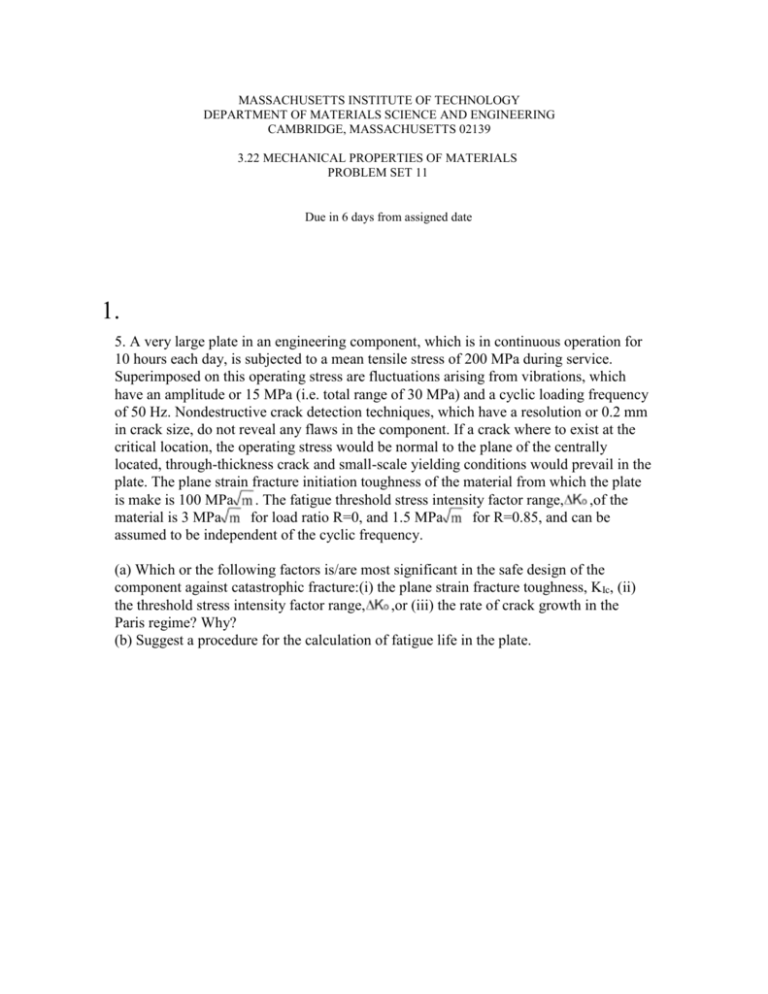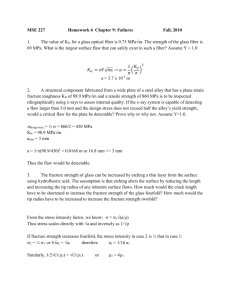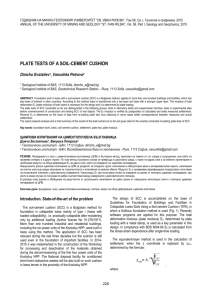massachusetts institute of technology department of materials
advertisement

MASSACHUSETTS INSTITUTE OF TECHNOLOGY DEPARTMENT OF MATERIALS SCIENCE AND ENGINEERING CAMBRIDGE, MASSACHUSETTS 02139 3.22 MECHANICAL PROPERTIES OF MATERIALS PROBLEM SET 11 Due in 6 days from assigned date 1. 5. A very large plate in an engineering component, which is in continuous operation for 10 hours each day, is subjected to a mean tensile stress of 200 MPa during service. Superimposed on this operating stress are fluctuations arising from vibrations, which have an amplitude or 15 MPa (i.e. total range of 30 MPa) and a cyclic loading frequency of 50 Hz. Nondestructive crack detection techniques, which have a resolution or 0.2 mm in crack size, do not reveal any flaws in the component. If a crack where to exist at the critical location, the operating stress would be normal to the plane of the centrally located, through-thickness crack and small-scale yielding conditions would prevail in the plate. The plane strain fracture initiation toughness of the material from which the plate is make is 100 MPa . The fatigue threshold stress intensity factor range, ,of the material is 3 MPa for load ratio R=0, and 1.5 MPa for R=0.85, and can be assumed to be independent of the cyclic frequency. (a) Which or the following factors is/are most significant in the safe design of the component against catastrophic fracture:(i) the plane strain fracture toughness, KIc, (ii) the threshold stress intensity factor range, ,or (iii) the rate of crack growth in the Paris regime? Why? (b) Suggest a procedure for the calculation of fatigue life in the plate. 2 3. A disgruntled employee in an engineering company is intent on destroying a large steel plate used in a valuable engineering component. One evening, after the normal working hours, he cuts a very sharp notch in the edge of the plate. He orients the sharp flaw normal to the direction in which tensile stresses are applied to the plate, with the hope that the flaw would eventually result in catastrophic fracture of the plate. As he is committing the crime, a bystander telephones the plant foreman at the foreman’s home. The foreman, who leaves his home two minutes after the notification is received, travels to the scene of the crime on his bicycle at an average speed of 15 km/hr. Would he have reached the plant in time to shut off the equipment before the plate fractures catastrophically? Here are some useful data for your analysis: (i) The plate is cyclically loaded uniformly from 5 to 85 kN at a frequency of 75 Hz. (ii) The plate is 18 cm wide and 0.5 cm thick. (iii) The yield strength of the steel is 1250 MPa and the plane strain fracture toughness is 48 MPa . (iv) The flaw introduced by the employee is 1 cm in length, through the thickness of the plate. (v) The bystander, who notified the foreman, reported to the police, by phone, that, in his judgment, the crack tip opening displacement corresponding to the peak load of each cycle. (vi) Post-failure fractographic examination revealed the presence of fatigue striations with a mean spacing of 2.5 * 10-4 mm at the point where the crack had grown by 2.5 mm from the initial 1 cm flaw. (vii) The distance from the foreman’s home to the factory is 5 km. (viii) The time interval between the two phone calls was 10 minutes. State all your assumptions clearly. 3 A piston, 9 cm in diameter, is used to increase the internal pressure in a cylinder from 0 to 50 MPa. The cylinder, which is made of peak-ages aluminum alloy (yield strength = 500 MPa, KIc = 35 MPa ), has the following dimensions: length = 20 cm, inner diameter = 9 cm, and outer diameter = 11 cm. This piston- cylinder arrangement suffered a malfunction which caused the cylinder to burst. Post failure analyses showed the presence of a defect in the form of an elliptical flaw 4.4 mm long at the inner wall, 1.5 mm deep an oriented normal to the hoop stress in the cylinder. Compute the magnitude of the pressure at which the cylinder burst.









